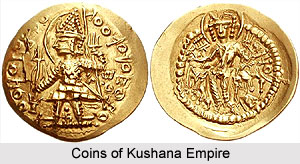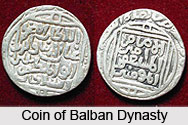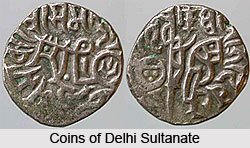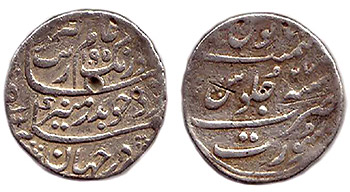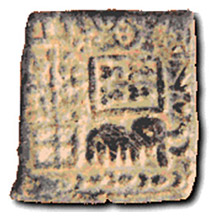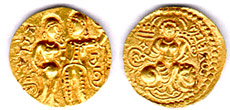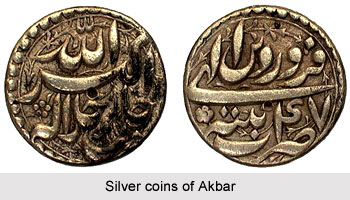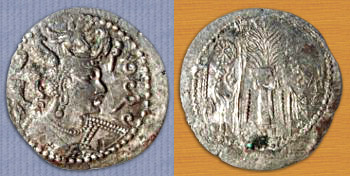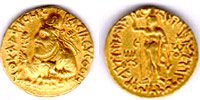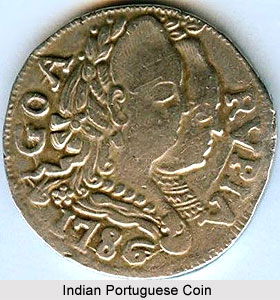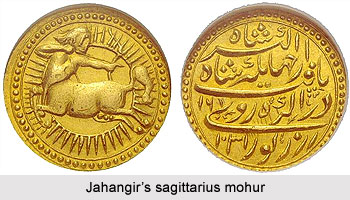 The Mughal Empire, primarily, witnessed the zenith of success in the time of Akbar. However coins were given due heed during the reign of Jahangir as well. In fact he took a personal interest to develop his coinage. Jahangir included his innovative qualities in issuing coins and later those became the characteristic of his coinage.
The Mughal Empire, primarily, witnessed the zenith of success in the time of Akbar. However coins were given due heed during the reign of Jahangir as well. In fact he took a personal interest to develop his coinage. Jahangir included his innovative qualities in issuing coins and later those became the characteristic of his coinage.
In 1605 A.D., after the demise of Akbar, Jahangir came to the throne. Though he was announced the ruler of the empire, Jahangir ordered not to issue any coin before his formal coronation. During this time, some gold coins were issued from Agra with a couplet and these coins are considered as the posthumous issues in the name of Akbar. Even some gold coins were issued during this time bearing the first regnal year of Jahangir and the Hijri year. During the interim period of 1605 to 1606 A.D., silver coins were issued with his name as Prince Salim. After the formal coronation of Jahangir, he ordered to increase the weight of gold and silver coins. Later when it was realized that the heavy weight coins were inconvenient in transactions, the old weight of the coins was restored. And till the end of his reigning period, gold and silver coins of these weights were issued.
Though in the time of Akbar, coins were issued from numerous places, in the time of Jahangir, a few places issued coins. Agra, Ahmedabad, Ajmer, Burhanpur and Delhi issued coins in silver, gold and copper. 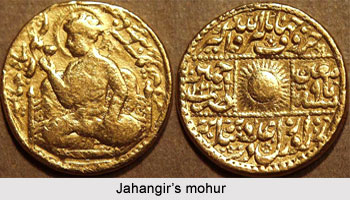 Ahmadnagar, Fathpur, Jahangirnagar, Kashmir, Patna and some other places issued gold coins and the silver coins were also issued from places like Surat, Ujjain etc. To establish his reigning period and make a mark of his own, he ordered to include a couplet in the gold and silver coins. But this order was not faithfully carried out and only during the first three years this legend was placed on the coins issued from Agra, Delhi and some other places. The coins issued during this period carried `Kalima` on one side and `Nuruddin Muhammad Jahangir Badshah Ghazi` on the flip side of the coin. Jahangir, in his ruling period, introduced his regnal year in the place of the Ilahi era and his coins bore the regnal year and the Hijri year.
Ahmadnagar, Fathpur, Jahangirnagar, Kashmir, Patna and some other places issued gold coins and the silver coins were also issued from places like Surat, Ujjain etc. To establish his reigning period and make a mark of his own, he ordered to include a couplet in the gold and silver coins. But this order was not faithfully carried out and only during the first three years this legend was placed on the coins issued from Agra, Delhi and some other places. The coins issued during this period carried `Kalima` on one side and `Nuruddin Muhammad Jahangir Badshah Ghazi` on the flip side of the coin. Jahangir, in his ruling period, introduced his regnal year in the place of the Ilahi era and his coins bore the regnal year and the Hijri year.
The coins that were issued in the time of Jahangir bore the name `Nuruddin Jahangir Shah Akbar Shah` on one side and the other side followed the Ilahi coins of Akbar. These coins bore the mint`s name, the Ilahi (Persian) month, the regnal and the Hijri years. Apart from these coins, couplets inscribed on the coins were also issued from different places of India and some other places outside India. These issues from each of these mints had couplets of their own with some individual characteristics. Later in his ruling period, Jahangir issued some gold coins that had portraits of his own, for being presented to his favourites. These coins were in the same tradition in which he had earlier issued the coin with the portrait of his father. Some coins were issued at the time of Jahangir that bore the bust of the emperor in profile. On some of the coins his posture with a flower or a cup in his right hand was seen. On the reverse side of the coin was a lion either to the right or to the left. Some coins displayed the emperor seated cross legged on the throne with a cup on the right hand and a legend on the reverse side of the coin. Later the coins issued displayed the seated emperor on one side and the lion on the other side of the coin.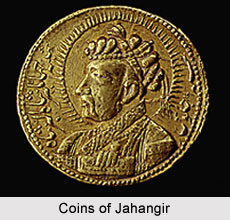 Each side of the coin occupied a hemistich of the metrical legend in the exergue. These coins did not carry the names of the place from where they were issued. The coins issued in the ruling period of Jahangir also manifested the portrait of the emperor holding a cup and each hemistich of the metrical legend is placed to the right and the left in the blank space. On the reverse side of the coin was a small sun in the centre, the name of the mint, the regnal year, the Hijri year and an invocation `Ya Muin` on its left and right of the coin.
Each side of the coin occupied a hemistich of the metrical legend in the exergue. These coins did not carry the names of the place from where they were issued. The coins issued in the ruling period of Jahangir also manifested the portrait of the emperor holding a cup and each hemistich of the metrical legend is placed to the right and the left in the blank space. On the reverse side of the coin was a small sun in the centre, the name of the mint, the regnal year, the Hijri year and an invocation `Ya Muin` on its left and right of the coin.
As per the historical evidences, Jahangir had mentioned in his diary about the replacement of the name of the month by the figure of configuration, which belonged to the month. After the announcement of this order of the emperor, the gold and silver coins issued from his camp mints contained the zodiacal signs on one side of the coin. During the later days of his reign, Jahangir lost his mental and physical stability and then the administration was entrusted to his queen Nurjahan. The coins that were issued from places like Agra, Ahmedabad, Akbarnagar, Allahbad, Kashmir, Patna, Surat etc bore a couplet that signified that `by order of Shah Jahngir gold attained a hundred beauties when the name of Nurjahan Badshah Begum was placed on it`. These coins continued till the termination of Jahangir`s reigning period and later during the time of Shah Jahan, these coins were returned to the mint and melted for carrying the zodiac signs. As a matter of fact, these coins are very rare. The coins of Jahangir had simple legends and the copper coins that were issued in the beginning of the reign follow the pattern of Akbar with the only change that the words `Shah Salimi` took the place of `Akbar Shahi`. These coins were issued from Ahmadabad.
Some of the coins of Jahangir bore the words like `Sikka Jahangir` on the obverse and `Sikka Rawani` on the reverse. The coins of the later years from the same mint had `Sikka Jahangiri` on the obverse and the mint name and the date on the reverse. On some coins, the word `raji` (current), or `raij-ul-wakt` (current in the period) or `rawan shud` (in currency) are seen on one side.
